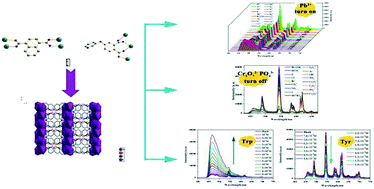A luminescent terbium coordination polymer as a multifunctional water-stable sensor for detection of Pb2+ ions, PO43− ions, Cr2O72− ions, and some amino acids†
Abstract
A terbium coordination polymer based on 4-(pyridin-3-yloxy)-phthalic acid (H2ppda) and 1,4-naphthalenedicarboxylic acid (H2nbdc), namely, [Tb(ppda)(npdc)0.5(H2O)2]n (1), features a two-dimensional layered structure and exhibits stable luminescence in the pH range of 2–12 in aqueous solution. It was found that compound 1 acted as a luminescent sensor for Pb2+ ions, PO43− ions, and Cr2O72− ions among various anions with excellent performance. The detection studies of amino acids showed that compound 1 could also be a multifunctional probe with high selectivity and sensitivity that discerned tyrosine (Tyr) and tryptophan (Trp) with the characteristic emission of Tb3+ ions and ligand luminescence in aqueous solution, respectively. It is the first lanthanide-based coordination polymer fluorescence probe for synchronous determination of Tyr and Trp in the presence of other amino acids, and the limits of detection for Tyr and Trp are both in the 10−5 M order of magnitude. Furthermore, the luminescence sensing mechanisms for different analytes were elaborated, respectively.



 Please wait while we load your content...
Please wait while we load your content...